Recon Jet in the Flesh
Ready, set, go. The Recon Jet is shipping. It's one of the most anticipated releases of a sports microelectronic in recent years, because of the promise of this advanced piece of wearable tech, and because of a numbers of delays.
It is the first eyewear product with a heads-up-display (HUD) geared for athletes. I've been riding and running it for the last couple of weeks.

The Recon Jet's features include GPS, Bluetooth Smart, Ant+, and WiFi connectivity. It has a built in altimeter, barometer, an optical touchpad that doesn't require the new "smart touch" style gloves. It also includes HD video, camera (1280×960) dual microphones, speaker, and it pairs to your smart phone.
It uses a lithium battery that is rechargeable and replaceable. It has an advertised life of 3 hours per use. It comes in white and black frames with a polycarbonate lens, 100% UV blocking and comes in polarized and in various tints. The low light lenses have a special ant-fog coating. Now that the specs are out of the way, how does it work? Almost perfectly.
The glasses weigh about 90 grams, with battery, or about 50 grams more than my Oakley Radarlocks. I noticed the additional weight and fit difference for the first two runs but then the glasses felt normal. You are announcing yourself as a triathlete to those who see you running in them.
What is the difference in fit? The Recon Jet sits slightly further from my face than my Oakleys. This wasn't bad or good, just notable. The lens quality was no different from my Oakleys. The Jet did not fog or accumulate sweat like my Oakleys do. I assume this was a result of the lenses sitting slightly further from my face. I learned that my initial concern about this affecting the HUD was unwarranted. The only effect I noticed was looking straight down at my feet while running (not recommended) with the Recon Jet was a bit trickier. Overall, it took no more than two runs with them to adjust to the weight, fit, and more importantly to the HUD.
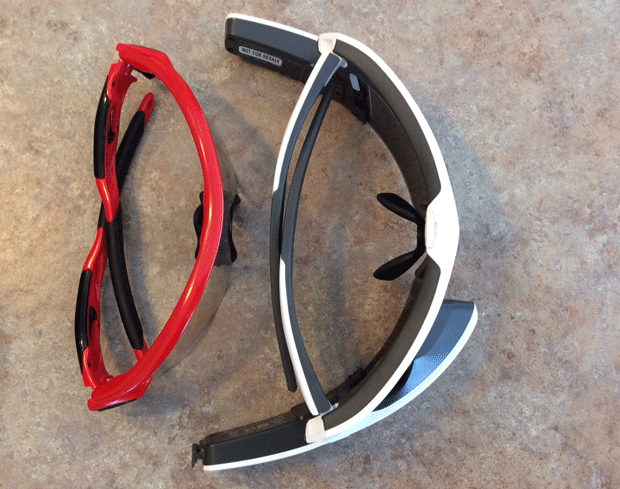
The HUD is projected on the right lens and is described as being the equivalent of a 30" television at 7 feet away. It has a brightness adjustment. It was easily readable and adjustable. The nose piece allows for macro adjustments for the HUD and then there is a small joystick that handles micro adjustment. There is also a setting called "Gaze Calibration" that further improves the clarity of the HUD. Recon says it wants to engineer a left-eye HUD but there is currently no timeline for this.
The HUD more-or-less disappeared when running and cycling once I became accustomed to its presence, and then became no different from looking at your watch/bike computer when you wanted to see your metrics. Early on, I found I spent more time looking at the HUD as it was novel but by the third run it wasn't a distraction at all. Although I was training with my sports watch as well, the Jet's HUD easily made the watch redundant and I enjoyed not having to look at my bike computer or wrist during activities.
Along with standard running and cycling metrics that can be displayed on the HUD, the Recon Jet also allows for pairing with smartphones. This feature opened a new realm of options.
When you pair your Recon Jet with your smartphone through Recon's free mobile software (Recon Engage, available for both iOS and Android), the HUD also displays information from your smartphone such as SMS messages and incoming calls. These messages appear slightly smaller across the bottom of your screen but are legible. I actually preferred this to the notification I get on my watch. I was also able to use the optical sensor to control my music playlist on my iPhone.
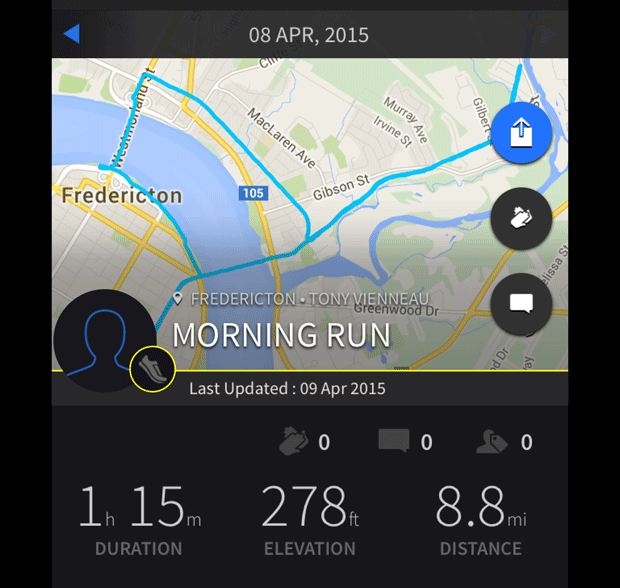
At the beginning of a new activity, users are prompted, asking if they wish to pair to their mobile device, or one can skip this step. The pairing process was simple and fast. One benefit with pairing the Recon Jet with your smartphone was faster GPS acquisition. The Recon Jet remembers location but if you travel a significant distance, it will need to re-acquire GPS satellites. When you pair with your smartphone, it is able to piggyback on your smartphone to quickly acquire your new location.
The mobile app also allows for "friends" to live track your activities when you pair with a smartphone. The live tracking does require friends or followers to open an Engage account, either via the mobile app or the web (both are free) to live track. The live tracking updates your position every minute for any friends following you. You do have privacy options to prevent anyone from seeing your account. The mobile app and desktop version work well and with a nice layout of your activities including: summary of your total activities, a more detailed view of each activity, friends, and live tracking.
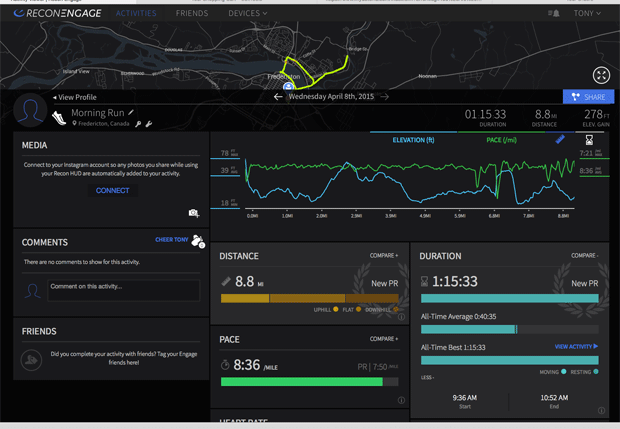
I relied mostly on two or three metrics displayed on the HUD which I found to be optimal in terms of display size (heart rate, pace/speed, time, or distance) although you have the option to display up to four (others include calories, cadence, elevation). The pairing of sensors was simple and there was no lag to the display. Users can then use the optical sensor to slide between different screen configurations that are customized via the Recon Engage website.
The optical sensor worked great in every weather condition, even while riding. Sliding front-to-back along the optical sensor displayed option screens while up-and-down changed the metrics displayed on the HUD. I found the front-to-back to be more of a natural movement than the up-and-down, but both worked well.
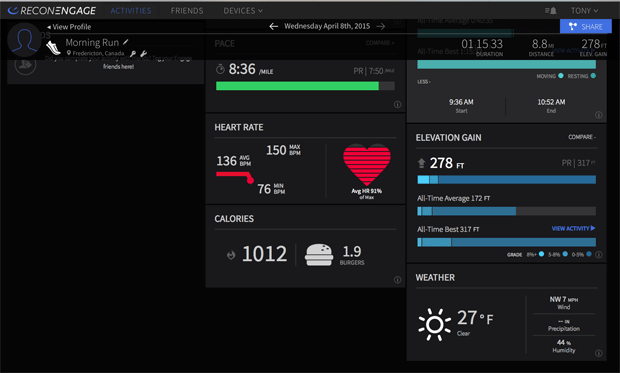
The Recon Jet currently uses 30-second pace smoothing from its internal GPS. I found this to be a tad long. I followed up with Recon who advised that this was not set in stone and that Recon will be adding additional pace metrics in the future, along with other metrics, to best meet the needs of their customers.
Being on the East Coast, I was able to test the Recon Jet in snow, rain, and freezing conditions. Pretty well everything but nice weather. It worked equally well in all conditions but I did notice in freezing conditions the battery life did decrease to a little over 2 hours.
Of note, although the Recon Jet fit very will with my Evade Road helmet, the Recon Jet will not fit with most TT helmets due to the closed earflaps.
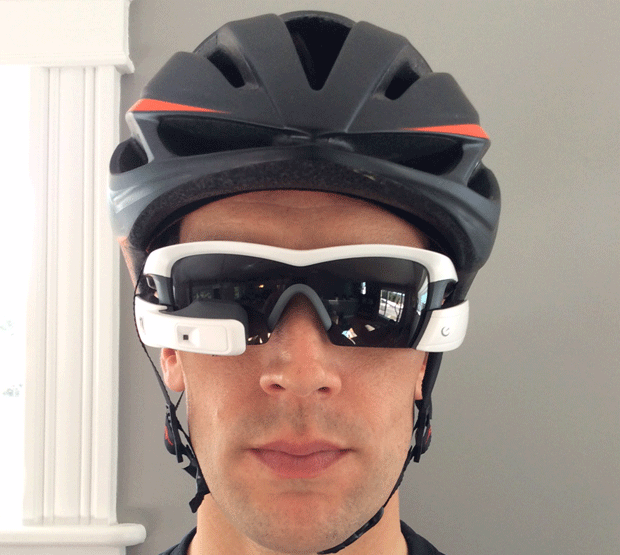
At the end of any activity, the Recon Jet can wirelessly upload your activity to its Engage software or mobile app. You can also do this with the supplied USB cable for charging and update the Recon Jet via the Engage software. The Engage software also can instantly push your data to TrainingPeaks, Strava, Facebook, etc, and the Engage software provides a nice platform in its own right. Any pictures or video taken during an activity will also show when synced with an activity. I was impressed at the quality of these images and that you didn't need to steer your head in a direction to capture an image. What you see through your lenses is exactly what the Recon Jet camera will capture.
At the end of your activity, the HUD will show summary statistics of your training activity. Currently, the post activity data displayed on the HUD is not correct but all the data pushed to Engage or the other sites is accurate. Recon is aware of this. Also, the elevation data displayed on the HUD originates from the Recon Jet but the web platform uses topographical data on the maps.
What's next? The Recon Jet operates on an open software platform that allows anyone to develop new apps/software and integrate existing software. For example, while running/cycling, you could be notified on the HUD that you are beginning a known Strava segment and when you finish the segment.
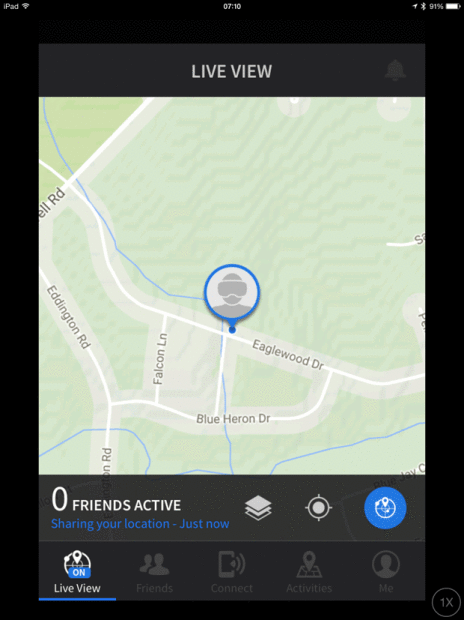
The Recon Jet is selling for $699. It can replace your sports watch ($200+), bike computer ($200+), and Oakley sunglasses ($250+) which almost saves you the money for all of that, depending on how you look at it. This is my inner voice justifying the cost. But in reality, this is what it does. It is the cost of innovation for a new wave of sports technology. I'm just trying to figure out how to wear them swimming.
Although Recon Jet supports Bluetooth sensors and power meters, neither of these are currently functioning. Recon states that a Bluetooth software update should be released very shortly for third party sensors and they are targeting June, 2015 for power meters. [corrected, we initially stated June, 2016]
For more info, here are the manufacturer links to the Recon Jet and to the Recon Engage software web home.



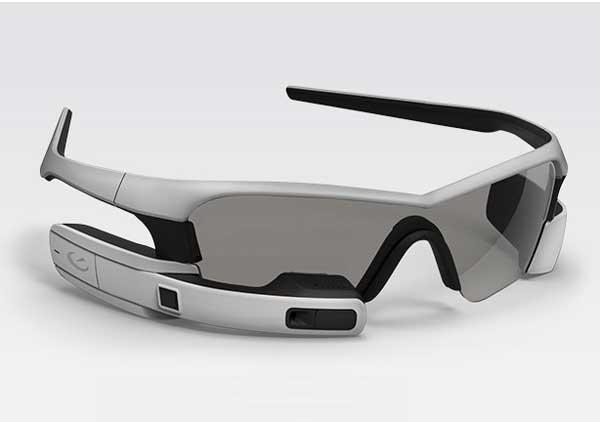


Start the discussion at forum.slowtwitch.com